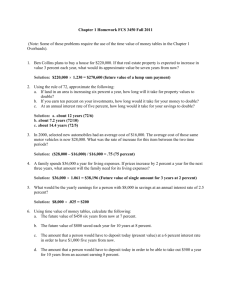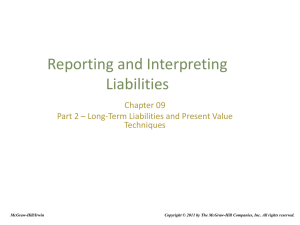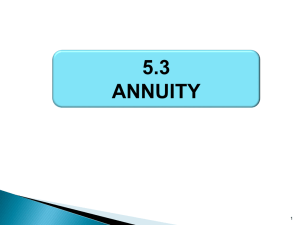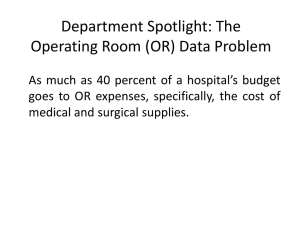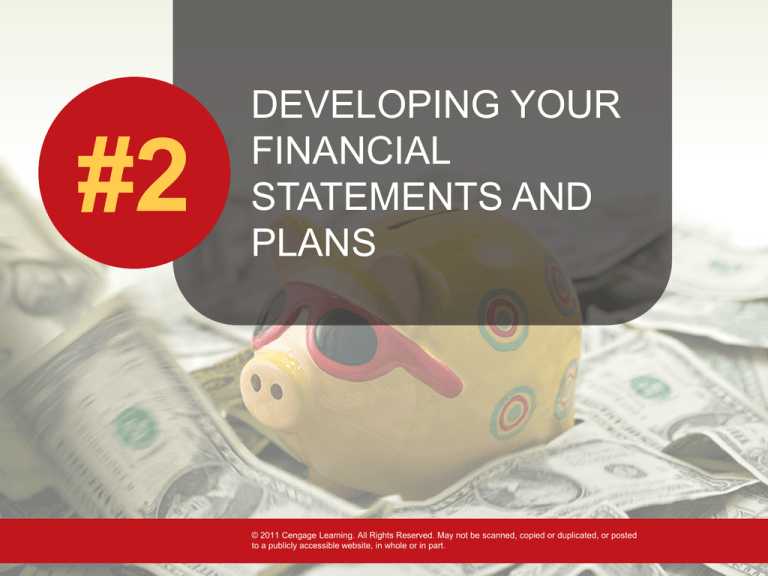
#2
DEVELOPING YOUR
FINANCIAL
STATEMENTS AND
PLANS
© 2011 Cengage Learning. All Rights Reserved. May not be scanned, copied or duplicated, or posted
to a publicly accessible website, in whole or in part.
Mapping Out Your
Financial Future
Financial planning facilitates:
• Greater wealth
• Financial security
• Attainment of financial goals
The Interlocking Network of Financial
Plans & Statements
Balance Sheet
A statement of
your financial
position at a
point in time
Balance Sheet Equation
Total Assets =
Total Liabilities
+
Net Worth
Assets: Things You Own
4 Broad Categories:
• Liquid assets –
low-risk, cash or
investments that can be
converted to cash with
little or no loss in value
• Investments –
acquired to earn a
return
• Real property –
immovable property
including land or a
house
• Personal Property –
movable property
such as autos and
home furnishings,
Liabilities: Money You Owe
Classified by Maturity
• Current or
short-term
due within a year
such as utility or
repair bills
• Long-term
due in a year or
more including
mortgages,
education and
consumer
installment loans
Net Worth: Measure of Your
Financial Worth
Actual wealth or equity that individuals
have in owned assets
Net worth = total assets – total liabilities
Net worth > 0 = SOLVENT
Net worth < 0 = INSOLVENT
The Income and
Expense Statement
A measure of financial performance
over a given time period
3 main parts:
• income
• expenses
• cash surplus (or deficit)
Income and Expense Statement
Total Income – Total Expenses =
CASH SURPLUS OR
(CASH DEFICIT)
Income: Cash In
•
•
•
•
•
•
Wages and salaries
Bonuses and commissions
Interest and dividends
Child support
Tax refunds
Gifts
Expenses: Cash Out
• Living Expenses
Housing, utilities,
food, insurance
• Tax Payments
Federal, state,
local
• Asset Purchases
Autos, furniture,
appliances
• Other Payments
Personal care,
recreation,
entertainment
Expenses: Cash Out
Fixed
• Contractual, equal
payments fixed
• rent or mortgage,
insurance, cable tv
payments
Variable
• Amounts change
from one period
to the next
• credit card
payments
How We Spend Our Income
Preparing the Income and
Expense Statements
• Record income from all sources
• Establish meaningful expense
categories
• Subtract total expenses from total
income to get cash surplus or deficit
Using Your Personal Financial
Statements
• Keeping good records
– Organize your records
• Tracking financial progress
– Balance Sheet ratios
– Income and Expense Statement ratios
Balance Sheet Ratios
Solvency Ratio
Net worth at a given point in time
Indicates potential to withstand financial
problems
Total net worth
Total assets
Liquidity Ratios
Measures ability to pay current debts with
existing liquid assets
“Current” = payment within one year
Liquid assets
Total current debts
Income & Expense Statement
Ratios
Savings Ratio
Shows percentage of after-tax income
saved during a time period
Cash surplus
Income after taxes
Debt Service Ratio
Indicates ability to repay loan
obligations promptly with before-tax
income
Total monthly loan payments
Monthly gross income
Preparing & Using Budgets
Budget
• Short-term financial planning report that
helps you achieve short-term financial goals
• Achieving short-term goals helps you
achieve longer-term goals
Using Budgets
•
•
•
•
•
Monitor and control finances
Allocate income to reach goals
Implement system of disciplined spending
Reduce needless spending
Achieve long-term financial goals
The Budgeting Process
• Estimate income
• Estimate expenses
• Finalize cash budget
Dealing with Deficits
• Shift expenses from
months with deficits to
months with surpluses
• Use savings,
investments, or
borrowing to cover
temporary deficits
If You End The Year In A Deficit
• Liquidate savings/investments
• Borrow to cover the deficit
• Cut low priority expenses;
alter spending habits
• Increase income
Using Your Budgets
• Budget Control Schedule compares
actual figures with various budget
categories and shows variances
• Continually update your budget based
upon the actual figures.
Time Value of Money
• Putting a Dollar Value on Financial Goals
• A dollar today is worth more than a dollar
received in the future because it can be
invested and earn interest.
Types of TVM Calculations
• Single sum — one lump sum investment
with no additions or subtractions
• Annuity — series of equal payments
made at fixed time intervals for a
specified number of periods
Future Value
• Value invested money will grow to become
earning a specific rate of interest over a
given time period
• Process of growing today’s present value to
a larger future value by applying compound
interest known as “compounding.”
Calculating the Future Value of a
Single Sum
Example:
What will $5000 grow to become
if invested at 5% for 6 years?
Calculating the Future Value of a
Single Sum
Tables
(Find Future Value Factor for 6 years and
5% in Appendix A)
FV = PV x Factor
$5000 x 1.340 =
$6700
Calculating the Future Value of an
Annuity
Example:
What would you accumulate if you
could invest $5630.70 every year
for the next 6 years at 5%?
Calculating the Future Value of an
Annuity
Tables
(Find Future Value Annuity Factor for
6 years and 5% in Appendix B)
FV = PMT x Factor
$5630.70 x 7.716 =
$38,300
Present Value
• Amount needed today to invest at a specific
rate of interest over a given time period to
accumulate a desired future amount
• “Discounting” - reverse of compounding process of working from the future value
back to present value
Calculating the Present Value of a
Single Sum
Example:
You wish to accumulate a retirement
fund of $300,000 in 25 years. If you
can invest at 5%, what single lumpsum deposit must you make today in
order to achieve your goal?
Calculating the Present Value of a
Single Sum
Tables
(Find Present Value
Factor for 25 years and
5% in Appendix C)
PV = FV x Factor
$300,000 x .295 =
$88,500
Calculator
(Set on 1 P/YR and
END mode.)
300000
FV
25 N
5
I
PV $88,590.83
Calculating the Present Value of an
Annuity
Example:
You have a $300,000 retirement fund
and wish to take out equal annual
withdrawals over the next 30 years.
How much can you withdraw if interest
rates are 5% on the investment?
Calculating the Present Value of an
Annuity
Tables
(Find Present Value Annuity Factor for 30
years and 5% in Appendix D.)
Annual withdrawal=
$300,000/15.373 =
$19.514.73

